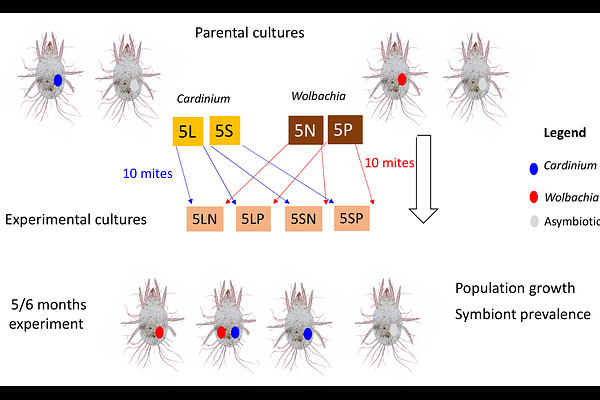Cultures of Tyrophagus putrescentiae experimentally infected with Cardinium and Wolbachia presented reduced fitness

Cultures of Tyrophagus putrescentiae experimentally infected with Cardinium and Wolbachia presented reduced fitness
Hubert, J.; Glowska-Patyniak, E.; Pekar, S.
AbstractTyrophagus putrescentiae is a cosmopolitan pest of stored food and animal feed. Mite populations differ in their microbiome composition, resulting in variability in their fitness. Cultures of the stored-product mite T. putrescentiae are often singly infected by one of intracellular bacterial genera Cardinium and Wolbachia. No naturally occurring multi-infected (Cardinium/Wolbachia) cultures have been observed. Under laboratory conditions, we mixed two singly infected mite cultures, i.e., Cardinium-infected (5L and 5S) and Wolbachia-infected (5N and 5P) cultures, to obtain four experimental cultures (5LN, 5LP, 5SN and 5SP), each infected with each of the endosymbionts. Population growth was used as a fitness indicator, and PCR with specific primers for a single mite was used to identify the prevalence of Cardinium and Wolbachia in the parental and mixed cultures. The population growth of the experimental cultures was lower than that of the parents at the beginning of the experiment. After six months, 5SN and 5SP exhibited greater fitness than 5LP and 5LN. The population growth of the 5SN and 5SP cultures did not differ from that of the parental cultures 5P and 5S. Cardinium-infected mites prevailed in 6 cultures, Wolbachia-infected mites in 5 cultures, and asymbiotic individuals in 1 culture after six months. The proportion of Cardinium-infected individuals (45%) was greater than that of Wolbachia-infected individuals (25%), indicating that Cardinium had the ability to overcome Wolbachia. Although the cultures were multi-infected, doubly infected mites were rare (7%). These results suggest that Cardinium is responsible for cytoplasmic incompatibility in T. putrescentiae. The results revealed that the presence of the intracellular symbionts Cardinium and Wolbachia strongly influenced mite population growth in the experiments. These data support the importance of the microbiome in this pest.